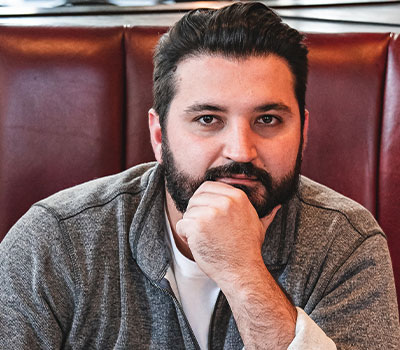Joaquin de la Cerda has been leading the team and wine program at Detroit’s Wright & Co. since mid-2021. At that time the restaurant had shifted from their late-night gastropub focus to one of more elevated dinner service. De la Cerda’s wine program offers an eclectic mix with popular classics, all intended to pair well with the array of flavors from their kitchen. Although Wright & Co. is part of a restaurant group known for cocktails and spirits, de la Cerda is pleased to see more of their customers turn to wine as their drink of choice to accompany dinner.
In its eighth year of service, Wright & Co. has emerged from the pandemic with a focus on elevated food and service along with a thoughtfully curated, approachable wine list. Their cocktail and spirits program continues to be an important part of the restaurant’s offerings; however, their wine sales are increasing as guests more often choose a glass or bottle with their meal. —Elaine Kim Heide


Have guest interactions changed or shifted due to the pandemic?
In service, we had to become much more fluid and dynamic in how we were giving our service. Masks were always the big debate and a really important part of slowing the spread. But they could sterilize service a little bit. As numbers went up, we’d tell staff that it was important to mask up. We’d keep an eye on the balance of what the guests wanted and what the staff wanted and what was socially responsible. This was just one aspect of it.
Things that would enable us to touch the table less. How we conducted service, such as how frequently we switched out plates. Now that we’re through 2022 we elevated our service by bringing some of those touches back. With different ebbs and flows of [COVID] surges we had to bring those touches forward and back. Now we’re back to full-steam service and we’re able to have a more elevated style.
Is there anything else that changed in your service style to raise it to a new tier?
Our menu very much allows for interpretation so it’s important that our staff understand all of the food, and based on what someone’s ordering how we would course that out. We do family-style service, so with wine service we’re getting away from the direct pairing of this dish and this wine. We’re going to what the overall experience looks like and what bottles complement that.
About 20% of your wine list is from little-known varieties or regions. How is this defined on your list?
Our list is structured from lightest- to fullest-bodied. This means that people aren’t scrolling through it based on price or by grape. With wines intermixed, the goal is to show a California cab next to a Spanish garnacha, next to some Rhône varieties, next to a Washington syrah. When guests look at what they know, they will notice what’s right next to it that might have some similarities. We don’t have a tremendously large list—about 65 to 70 bottles. If someone is looking for one particular wine we could have a couple options for them. But we have a plethora of other options which makes the conversation inherently organic and easy to have.
I had a table the other day that said they wanted something with a touch of funk to it. They didn’t want a pét-nat but wanted something that was lighter-bodied with high acid. We went toward an Austrian pinot or a Loire cab franc that was also lighter in body but had a little bit more meatiness to the taste. We get to have those kinds of conversations.
Wine’s share of total sales is slightly on the rise. What’s driving this increase and are you actively working toward this?
One tactic was to reformat the beverage menu as a whole. Rather than being in a leather-bound book [with spirits], we moved it to the flipside of the beverage menu. This just made the wine list much more approachable. We try to price our wine list so there’s approachability for everybody. If you’re looking for something sweet you can have something $50–70 range. If you want to do a dope Spätlese riesling, it will be a little more expensive. If you want a cab, you can get something in the $50–60 range, or $70–90, or $150 range. Same thing for most of our categories: Northern Italy, Southern France, California, Oregon.
Anything else you’d like to share?
There was one thing I wanted to point out about our list. We always keep a section on the menu called our “Last Bottle Special.” We have our staples that we like to keep and we also like to move things over, but I don’t have a lot of real estate in our storage space. In changing seasons we like to blow through some reds before white season. So we like to have at least three or four wines on there that are deeply discounted at least 30–40 percent so there’s always something exciting that’s very approachable.
Detroit’s a fun city and we’re starting to see a lot more interest in wine. During the pandemic, beverage sales as a whole definitely went up. A lot of our guests who came in the mid-2010s are now a little bit older, so we have evolved the experience to the changing times and to what our guests want.
This is a W&S web exclusive. Get access to all of our feature stories by signing up today.
















